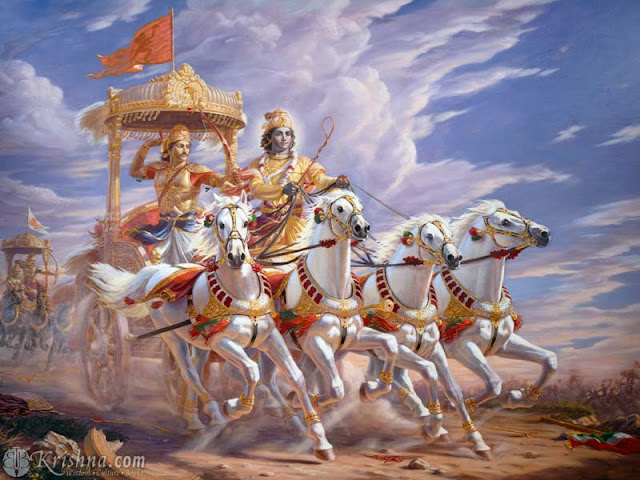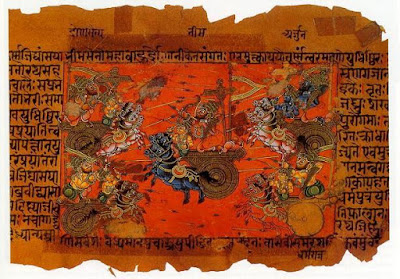The Bhagavad Gita is undoubtedly one of the most inspired texts that humanity possesses. In Hinduism it is considered a sacred text, and it is also the first written text that deals with yoga.
The entire text (700 verses) is a dialogue between the teacher (Krishna) and his disciple (Arjuna), where he instructs him in yoga just before starting a battle between the Pándavas and the Kauravas. Bhagavad Gita means " the song ( gita ) of Krishna ( Bhagavan ) ", although because bhagavan is a venerable title meaning "Lord," it is often translated as "The song of the Lord," or "The song of God". Also, due to its importance as a yoga text, it is known as Yoga upanishad .

For Hinduists, Krishna is an avatar of the god Visnhu (the Conservative). The text is part of the great epic called Mahabarata , and has the quality of sruti (revealed text) and smriti (remembered text). Its authorship is unknown, although the wise Viasa is the author of the Mahabarata .
As in any religious text, there are numerous versions and translations , some of them faithful to the original in Sanskrit, others manipulated or stained according to the ideology of the one who translated it. There are illegible versions (due to its literality with the Sanskrit language) and very poetic versions (adapted to the Castilian language in this case). There are versions that are limited to reproducing the original text, and others full of comments between paragraph and paragraph by the translator, a fact that cuts the narrative and can create confusing ideas.
For me, the best version I know is that of 1896 by J. Roviralta Borrell , a Spanish theosophist. Srila Prabhupada's version is very good also if we read only the rough and faithful translation to the original text; The rest of the book are his comments, very tinged with his Hare Krishna ideology. There are dozens of versions, I don't know all of them.
Well, like any sacred text, it can have two interpretations: literal or symbolic . That is, we can believe that the story really happened and that Krishna was an incarnation of God, or interpret the text symbolically, assigning each character and situation in the story as a part of ourselves, as a universal archetype :
- Krishna : inner teacher (spirit).
- Arjuna : mature psyche (soul).
- Blind King Diritarastra and his son Dur and odhana ("how hard to gnaw"): personality.
- Sanjaya ( court seer): the storyteller, who has the ability to see beyond the material (intuition).
- Army of the Pándavas : The luminous forces that elevate us towards spirituality.
- Army of the Kauravas : The dark forces that drag us towards matter.
- Kurukshetra (plain where the battle takes place): Our body (the stage where everything happens to us).

I are uploading the videos on my Youtube channel, and I will also upload them to Ivoox in Mp3 format.
Gopal















0 comentarios :
Post a Comment